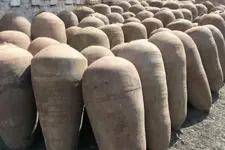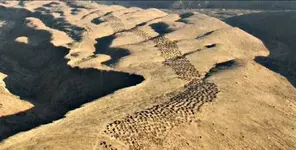You are using an out of date browser. It may not display this or other websites correctly.
You should upgrade or use an alternative browser.
You should upgrade or use an alternative browser.
Misc data and adventures of a Tayopa treasure hunter
- Thread starter Real de Tayopa Tropical Tramp
- Start date
BillA
Bronze Member
Hola Kanacki, pretty nice target full of pillar dollars
what would the Italians have brought for payment?
and Crow, you seem to have a location
what would the Italians have brought for payment?
and Crow, you seem to have a location
Last edited:
tintin_treasure
Hero Member
- Joined
- Jul 8, 2014
- Messages
- 688
- Reaction score
- 1,838
- Golden Thread
- 0
- Primary Interest:
- All Treasure Hunting
Hi Billa
When Crow and trio show interest on the plausibility of a yarn it is something worth to listen to ,,,some years back there was a story about a possible discovery of an underground lost Nazi train with gold in Poland and the news was all over the place...it was alleged by a treasure hunter who claimed he had a credible information... but Crow expressed his doubts saying the story and claims of the person did not add up ...but we were head over heels interested in the story that spanned several months and Poland was in uproar and that small town was the focus and destination of treasure yarn crowds...I think the army even was sent to protect the alleged land.. Finally after various high level involvement of university researchers with high tech analysis, what was believed to be a lost train was finally found out to be something else
,,,some years back there was a story about a possible discovery of an underground lost Nazi train with gold in Poland and the news was all over the place...it was alleged by a treasure hunter who claimed he had a credible information... but Crow expressed his doubts saying the story and claims of the person did not add up ...but we were head over heels interested in the story that spanned several months and Poland was in uproar and that small town was the focus and destination of treasure yarn crowds...I think the army even was sent to protect the alleged land.. Finally after various high level involvement of university researchers with high tech analysis, what was believed to be a lost train was finally found out to be something else  ...but that small town thanks to that treasure hunter got its treasure big time by the flooding tourists...
...but that small town thanks to that treasure hunter got its treasure big time by the flooding tourists...
TT
When Crow and trio show interest on the plausibility of a yarn it is something worth to listen to
 ,,,some years back there was a story about a possible discovery of an underground lost Nazi train with gold in Poland and the news was all over the place...it was alleged by a treasure hunter who claimed he had a credible information... but Crow expressed his doubts saying the story and claims of the person did not add up ...but we were head over heels interested in the story that spanned several months and Poland was in uproar and that small town was the focus and destination of treasure yarn crowds...I think the army even was sent to protect the alleged land.. Finally after various high level involvement of university researchers with high tech analysis, what was believed to be a lost train was finally found out to be something else
,,,some years back there was a story about a possible discovery of an underground lost Nazi train with gold in Poland and the news was all over the place...it was alleged by a treasure hunter who claimed he had a credible information... but Crow expressed his doubts saying the story and claims of the person did not add up ...but we were head over heels interested in the story that spanned several months and Poland was in uproar and that small town was the focus and destination of treasure yarn crowds...I think the army even was sent to protect the alleged land.. Finally after various high level involvement of university researchers with high tech analysis, what was believed to be a lost train was finally found out to be something else  ...but that small town thanks to that treasure hunter got its treasure big time by the flooding tourists...
...but that small town thanks to that treasure hunter got its treasure big time by the flooding tourists...TT
BillA
Bronze Member
TT
I correspond with these guys by choice.
The fraud you referred to is ongoing, since even before the WWII ended. A very long tale.
be cool
I correspond with these guys by choice.
The fraud you referred to is ongoing, since even before the WWII ended. A very long tale.
be cool
tintin_treasure
Hero Member
- Joined
- Jul 8, 2014
- Messages
- 688
- Reaction score
- 1,838
- Golden Thread
- 0
- Primary Interest:
- All Treasure Hunting
TT
I correspond with these guys by choice.
The fraud you referred to is ongoing, since even before the WWII ended. A very long tale.
be cool
Hi Billa ,,I am not sure you got what I meant...I was saying discussing with Crow and Trio is interesting and worthwhile..
Anyway you are right about many ongoing stories relate to WWII..
TT
Crow
Silver Member
- Joined
- Jan 28, 2005
- Messages
- 4,024
- Reaction score
- 11,210
- Golden Thread
- 0
- Location
- In a tax haven some where
- Detector(s) used
- ONES THAT GO BEEP! :-)
- Primary Interest:
- Other
Hola Kanacki, pretty nice target full of pillar dollars
what would the Italians have brought for payment?
and Crow, you seem to have a location
Maybe maybe not? Possible but not conclusive.
Crow
Crow
Silver Member
- Joined
- Jan 28, 2005
- Messages
- 4,024
- Reaction score
- 11,210
- Golden Thread
- 0
- Location
- In a tax haven some where
- Detector(s) used
- ONES THAT GO BEEP! :-)
- Primary Interest:
- Other
Between Kanacki and I we have identified 7 Estancia sites 4 are in center of small hamlets or villages one is in centre of sizeable town 2 are ruins almost untraceable. The other 7 are not found yet? But two are sandwich between a site that my informant mentioned a mysterious site known some as La Hoya among other names.
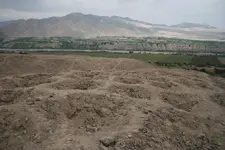
The Band of Holes also known in Spanish as Monte Sierpe (serpent mountain) or Cerro Viruela (smallpox hill), is a series of about 5,000-6,000 man-sized holes found in the Pisco Valley on the Nazca Plateau in Peru. Local people have no idea who made them or how they were used.
However Some engineers believe its a rain water collection and filtration device. water condenses from fog in the high hills and collects in holes soaking down and filtering through the water table.
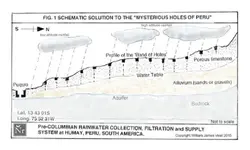
This capilla is near this ancient landmark. In fact it is about half way between to former estancias and both properties trail off into the desert.
Crow

The Band of Holes also known in Spanish as Monte Sierpe (serpent mountain) or Cerro Viruela (smallpox hill), is a series of about 5,000-6,000 man-sized holes found in the Pisco Valley on the Nazca Plateau in Peru. Local people have no idea who made them or how they were used.
However Some engineers believe its a rain water collection and filtration device. water condenses from fog in the high hills and collects in holes soaking down and filtering through the water table.

This capilla is near this ancient landmark. In fact it is about half way between to former estancias and both properties trail off into the desert.
Crow
Crow
Silver Member
- Joined
- Jan 28, 2005
- Messages
- 4,024
- Reaction score
- 11,210
- Golden Thread
- 0
- Location
- In a tax haven some where
- Detector(s) used
- ONES THAT GO BEEP! :-)
- Primary Interest:
- Other
BillA
Bronze Member
TT, as an aside
You doubtless have noticed that leading conversations are a tool, my function here is didactic.
We have a obscure pool with interesting denizens, koy or clown who knows. They sometimes surface and belch?
We, as interested spectators, provide chum. Some tales are never mentioned, and some have only that kind of tale.
be cool
You doubtless have noticed that leading conversations are a tool, my function here is didactic.
We have a obscure pool with interesting denizens, koy or clown who knows. They sometimes surface and belch?
We, as interested spectators, provide chum. Some tales are never mentioned, and some have only that kind of tale.
be cool
BillA
Bronze Member
Crow
no no, that band of pits is running on the same elevation across a series of hillocks?
edit: got a higher shot at a different time?
no no, that band of pits is running on the same elevation across a series of hillocks?
edit: got a higher shot at a different time?
Last edited:
Crow
Silver Member
- Joined
- Jan 28, 2005
- Messages
- 4,024
- Reaction score
- 11,210
- Golden Thread
- 0
- Location
- In a tax haven some where
- Detector(s) used
- ONES THAT GO BEEP! :-)
- Primary Interest:
- Other
Pisco at the time was dirty stinking disease ridden backwater with no proper sanitation. Cholera can quickly become fatal. In the most severe cases, the rapid loss of large amounts of fluids and electrolytes can lead to death within hours. In less extreme situations, people who don't receive treatment can die of dehydration and shock hours to days after cholera symptoms first appear. It was reason why the sick and dying crew went Estanica to hydrate with finely filtered fresh water. But unfortunately most was too far gone from shock the body was going through from symptoms.
Being not privy to the full document is hard to determine if the pillar dollars was from the ship or later from the Spanish family operating the estancia post Jesuit expulsion?
Crow
Being not privy to the full document is hard to determine if the pillar dollars was from the ship or later from the Spanish family operating the estancia post Jesuit expulsion?
Crow
Last edited:
Crow
Silver Member
- Joined
- Jan 28, 2005
- Messages
- 4,024
- Reaction score
- 11,210
- Golden Thread
- 0
- Location
- In a tax haven some where
- Detector(s) used
- ONES THAT GO BEEP! :-)
- Primary Interest:
- Other
Crow
no no, that band of pits is running on the same elevation across a series of hillocks?
edit: got a higher shot at a different time?
Gidday Bill good point My sediments exactly. I think the holes was ceremonial belong to the local Nazca culture? It is just coincidence ground water under the sand is filtering water from the hilLs where moisture condenses. DiG a hole almost anywhere you find ground water.
The region is really dangerous for liquefaction in earthquakes. That is why most of old adobe building are destroyed.
Crow
Last edited:
Crow
Silver Member
- Joined
- Jan 28, 2005
- Messages
- 4,024
- Reaction score
- 11,210
- Golden Thread
- 0
- Location
- In a tax haven some where
- Detector(s) used
- ONES THAT GO BEEP! :-)
- Primary Interest:
- Other
I suspect my informant found via a 1931 picture of ruin Capilla in a estancia to west closer to the coast and mistook that ruin for the site. Thus he said so himself that directions names and clues did not match?
So there is the problem the two possible sites to the east in question, there are villagers almost in plain view. So any search there is highly complicated and problematic.
Crow
So there is the problem the two possible sites to the east in question, there are villagers almost in plain view. So any search there is highly complicated and problematic.
Crow
BillA
Bronze Member
fascinating, a modern understandingThe region is really dangerous for liquefaction in earthquakes. That is why most of old adobe building are destroyed.
Crow
BillA
Bronze Member
my personal experience is that as an outsider one will always be under observation,So there is the problem the two possible sites to the east in question, there are villagers almost in plain view. So any search there is highly complicated and problematic.
Crow
and that one's actions will be a topic of discussion
any worthwhile cover must include use of a shovel, most difficult
Crow
Silver Member
- Joined
- Jan 28, 2005
- Messages
- 4,024
- Reaction score
- 11,210
- Golden Thread
- 0
- Location
- In a tax haven some where
- Detector(s) used
- ONES THAT GO BEEP! :-)
- Primary Interest:
- Other
TT its late amigo
The polish Gold train myth was manifestation of runours taken from one location and reported in another. A real treasure train. The idea of a Nazi “gold train” has a real historical version as well. On December 15, 1944, a train left Hungary carrying an estimated $570 million to $1.7 billion (in 2007 values) worth of treasure. The gold and treasure, which left Hungary to escape the advancing Soviet army, made a number of stops to transfer its valuables to various trucks as it meandered through Hungary and into Austria. It was eventually seized by the advancing Allies in May of that year.
View attachment 1873697
Distant memory of that real event spawn Nazi treasure train legends.
Some times amigo the same story reinvents itself into multiple versions.
Crow
The polish Gold train myth was manifestation of runours taken from one location and reported in another. A real treasure train. The idea of a Nazi “gold train” has a real historical version as well. On December 15, 1944, a train left Hungary carrying an estimated $570 million to $1.7 billion (in 2007 values) worth of treasure. The gold and treasure, which left Hungary to escape the advancing Soviet army, made a number of stops to transfer its valuables to various trucks as it meandered through Hungary and into Austria. It was eventually seized by the advancing Allies in May of that year.
View attachment 1873697
Distant memory of that real event spawn Nazi treasure train legends.
Some times amigo the same story reinvents itself into multiple versions.
Crow
Crow
Silver Member
- Joined
- Jan 28, 2005
- Messages
- 4,024
- Reaction score
- 11,210
- Golden Thread
- 0
- Location
- In a tax haven some where
- Detector(s) used
- ONES THAT GO BEEP! :-)
- Primary Interest:
- Other
my personal experience is that as an outsider one will always be under observation,
and that one's actions will be a topic of discussion
any worthwhile cover must include use of a shovel, most difficult
There are many factors to be aware of in such projects firstly we have no verifiable documentation other than a portion of an alleged document as shown and no clear amount of coin we are dealing with. Thirdly there are no deals or processes are in place to successful search and recover. And most of get keep such finds from a lot of expense and effort. While an interesting exercise in the probability of developing the logistics to do such a project.
The project does not meet all criteria that meets the trio's modus operandi.
Its late and old crow needs to shut his beak and roost.
Crow
Last edited:
tintin_treasure
Hero Member
- Joined
- Jul 8, 2014
- Messages
- 688
- Reaction score
- 1,838
- Golden Thread
- 0
- Primary Interest:
- All Treasure Hunting
TT its late amigo
The polish Gold train myth was manifestation of runours taken from one location and reported in another. A real treasure train. The idea of a Nazi “gold train” has a real historical version as well. On December 15, 1944, a train left Hungary carrying an estimated $570 million to $1.7 billion (in 2007 values) worth of treasure. The gold and treasure, which left Hungary to escape the advancing Soviet army, made a number of stops to transfer its valuables to various trucks as it meandered through Hungary and into Austria. It was eventually seized by the advancing Allies in May of that year.
View attachment 1873697
Distant memory of that real event spawn Nazi treasure train legends.
Some times amigo the same story reinvents itself into multiple versions.
Crow
Yes Crow, ,,,if memory serves me right even in the polish saga it was based on a long standing rumour or legend of a lost train with gold in poland ...but it just was not the one he thought he saw by the ground penetrating imagery...when he saw an image that looks like a train added to the legend in the area , he put two and two together and he assumed he struck the jackpot..his judgment were clouded as he saw what he wanted to see..
TT
Crow
Silver Member
- Joined
- Jan 28, 2005
- Messages
- 4,024
- Reaction score
- 11,210
- Golden Thread
- 0
- Location
- In a tax haven some where
- Detector(s) used
- ONES THAT GO BEEP! :-)
- Primary Interest:
- Other
Gidday amigos
And what of the alleged 2013 report of discovery of money and silver? A Peruvian local who lived in Pisco who does a lot of detecting searched an old colonial building ruin in Tacena not in the Pisco valley and found leather bag with one pound of jewellery and old silver pillar dollars in a false beam. So in effect not connected to the alleged Pisco Ruin story.
So there ya have it amigos . Is there silver pillars dollars and gems hidden in a old clay wine jar buried near a ruined capilla devoted to Italian seamen of the vessel abandoned and looted and crew who died of cholera? On or near two estancias and an ancient alignment of holes that are a mystery in themselves?
Old crow has to fly for now....
Crow
And what of the alleged 2013 report of discovery of money and silver? A Peruvian local who lived in Pisco who does a lot of detecting searched an old colonial building ruin in Tacena not in the Pisco valley and found leather bag with one pound of jewellery and old silver pillar dollars in a false beam. So in effect not connected to the alleged Pisco Ruin story.
So there ya have it amigos . Is there silver pillars dollars and gems hidden in a old clay wine jar buried near a ruined capilla devoted to Italian seamen of the vessel abandoned and looted and crew who died of cholera? On or near two estancias and an ancient alignment of holes that are a mystery in themselves?
Old crow has to fly for now....
Crow
KANACKI
Bronze Member
- Joined
- Mar 1, 2015
- Messages
- 1,445
- Reaction score
- 5,938
- Golden Thread
- 0
- Primary Interest:
- All Treasure Hunting
Hola amigos just a small footnote
The other Jesuit estancia of the two has a new church but there is traces of the old church which gives hint of substantial size of the old Jesuit church. the church outbuilding became incorporated in peoples houses. Here is a picture below.
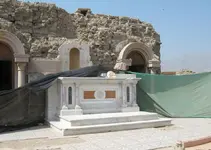
This is above the same site where I posted the picture of the park with the date palms. The village was converted out of the old Jesuit estancia. Behind the village is an old cemetery. Behind that further out into desert sand is an old ruined foundation that could possibly be a capellia?
But here is the catch the other Jesuit site ruin where Crow posted has also out buildings and foundations trailing off into the desert. Which one has the Capilla foundation if any?
That is the money question amigos.
Kanacki
The other Jesuit estancia of the two has a new church but there is traces of the old church which gives hint of substantial size of the old Jesuit church. the church outbuilding became incorporated in peoples houses. Here is a picture below.

This is above the same site where I posted the picture of the park with the date palms. The village was converted out of the old Jesuit estancia. Behind the village is an old cemetery. Behind that further out into desert sand is an old ruined foundation that could possibly be a capellia?
But here is the catch the other Jesuit site ruin where Crow posted has also out buildings and foundations trailing off into the desert. Which one has the Capilla foundation if any?
That is the money question amigos.
Kanacki
Similar threads
Users who are viewing this thread
Total: 2 (members: 0, guests: 2)

